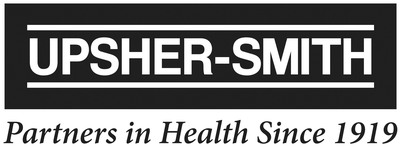

PHILADELPHIA, Dec. 7, 2015 /PRNewswire/ -- Upsher-Smith Laboratories, Inc., today announced that Phase 1 clinical trial data from USL261 (midazolam nasal spray) in healthy geriatric and non-geriatric adults were presented at the 69th Annual Meeting of the American Epilepsy Society (AES) in Philadelphia, December 4-8, 2015. These data support the continued clinical development of midazolam nasal spray and inform its potential use in elderly patients. Abstracts of the poster presentations can be found online at www.aesnet.org.

USL261 is a novel, investigational midazolam formulation, specifically designed for intranasal delivery, being developed for the rescue treatment of seizures in patients who require control of intermittent bouts of increased seizure activity, such as seizure clusters or acute repetitive seizures. It is intended to be delivered intranasally, without active inhalation by the patient. USL261 has been granted orphan drug designation for this use by the Food and Drug Administration (FDA).
"Upsher-Smith is pleased to present the findings from this study for the first time at this year's American Epilepsy Society meeting," said William Pullman, MB, BS, BMedSc, PhD, FRACP, Chief Scientific Officer and Biotech Research Institute Division President, Upsher-Smith. "Seizure clusters impact patients over the age of 65 as well as younger patients, and therefore, it was important that we characterize the pharmacokinetic and pharmacodynamic profile of USL261 in the geriatric population."
About the Study
The Phase I study examined the pharmacokinetics, pharmacodynamics, and tolerability of USL261 in healthy geriatric (≥65 years; n=18) and non-geriatric (18-40 years; n=12) adults.
The randomized, double-blind, two-way crossover study consisted of single doses of USL261 (2.5 mg and 5 mg) separated by a washout period of at least four days. Blood sampling was performed prior to and through 24 hours post-dose.
Key study findings
Pharmacokinetics (PK)
Pharmacodynamics (PD)/Tolerability
About Epilepsy
Epilepsy is a medical condition that is characterized by recurrent seizures. More than two million people in the U.S. are estimated to be affected by epilepsy, with about 150,000 new cases of epilepsy diagnosed each year.1 Epilepsy can be associated with profound physical, psychological and social consequences that negatively impact people's lives.
About Seizure Clusters
Seizure clusters, also referred to as acute repetitive seizures, seizure flurries, crescendo seizures, cluster seizures, or bouts of increased seizure activity, consist of multiple seizures which occur over a relatively brief period of time with a pattern distinguishable from the patient's usual seizure pattern.2
Reports of seizure cluster prevalence vary depending on the population evaluated. Seizure clusters have been associated with worse seizure control.3 In a study conducted in a tertiary epilepsy center in patients with a broad range of seizure control, the prevalence of seizure clusters was close to 30%.3 The number of patients with epilepsy in the United States who experience seizure clusters has been estimated to be 152,000.4,5,6,7
About Upsher-Smith
Upsher-Smith Laboratories, Inc., founded in 1919, is a growing, fully integrated pharmaceutical company dedicated to its mission of delivering high-value, high-quality therapies and solutions which measurably improve individuals' lives. As a family-owned pharmaceutical company, we are able to adapt and thrive in a dynamic healthcare environment. Our world is constantly evolving, and we are continually adapting to the ever-changing needs of patients, physicians, pharmacists, and healthcare organizations. Where there is a need, we will work to deliver solutions that simplify access to treatment, deliver better health outcomes, and enhance life. Upsher-Smith has a particular focus on developing therapies for people living with central nervous system (CNS) conditions, such as seizure disorders. For more information, visit www.upsher-smith.com.
References
Logo - http://photos.prnewswire.com/prnh/20130520/NY17281LOGO
SOURCE Upsher-Smith Laboratories, Inc.